Joyce Criticism: “Finnegans Wake” 4. About the Wake
- At January 06, 2022
- By Great Quail
- In Joyce
 1
1
Finnegans Wake: About the Wake
The works profiled below are about Finnegans Wake itself as a work of literature: the rough drafts, manuscripts, publishing history, etc. The books are listed by publication date. Clicking a cover image takes you to Amazon.com. When Brazen Head commentary is unavailable, the publisher’s summaries are usually reprinted. If any knowledgeable Joyce reader would like to review, summarize, or provide additional information for any of these “uncommented” books, please drop us a line! Additional Wake criticism may be found by clicking the links below:
Finnegans Wake Criticism
[Main Page | Guides & Annotations | Criticism 1929-1999 | Criticism 2000-Present | About the Wake | Independent]
Anna Livia Plurabelle: The Making of a Chapter
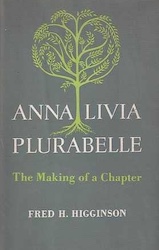
Anna Livia Plurabelle: The Making of a Chapter
By James Joyce. Edited by Fred H. Higginson
University of Minnesota Press, 1960
Available online at: Internet Archive
This book traces the evolution of “Anna Livia Plurabelle” from Joyce’s 1923 “red-backed notebook” to the final version in Finnegans Wake. It contains explicatory material on ALP, numerous transcripts, and a textual appendix.
James Joyce’s Scribbledehobble: The Ur-Workbook for Finnegans Wake
James Joyce’s Scribbledehobble: The Ur-Workbook for Finnegans Wake
By James Joyce. Edited by Thomas E. Connolly
University of Wisconsin Press, 1961
Scribbledehobble is an attempt to render into text Joyce’s handwritten notebooks that provided material for Finnegans Wake. The book includes photographic facsimiles of seven pages. Right from publication, reviewers called attention to Connolly’s numerous errors and apparent gaps of knowledge in subjects such as Gaelic, Catholic liturgy, Irish mythology, and Dublin topography. Referring to the history of such literary endeavors, The New York Times reviewer wrote, “Mr. Connolly seems to know nothing.”
A First-Draft Version of Finnegans Wake
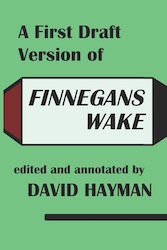
A First-Draft Version of Finnegans Wake
By James Joyce. Edited and Annotated by David Hayman.
University of Texas Press, 1963
Available online at: Internet Archive | University of Wisconsin-Madison
Publisher’s Description: No book by a modern author has a richer history than Finnegans Wake, upon which James Joyce lavished seventeen years of creative effort, painfully achieving like the “Ondt” in his own fable the right to enjoy his leisure. The finished novel, a joyous and fiddling “Gracehoper,” crawled into existence from beneath a mound of almost numberless drafts. Some nine thousand pages of holograph, typescript, and revised proof now preserved in the British Museum attest the nature of the book’s development and the variegated character of the artist’s inspiration. With the fifty-odd notebooks that constitute the Finnegans Wake papers at the University of Buffalo they afford excellent insights into the character of the creative act and of the ideas that underlie the Wake’s creation.
For several years David Hayman studied the draft notebooks, the fair copies, the typescripts, the proof sheets, the notes for additions and changes, the galley proof, the corrected page proof—all the documents that form the record of Joyce’s composition and revision of Finnegans Wake. Mr. Hayman has attempted to “expose within the artificial unity of a liberally defined first-draft version as many as possible of the salient aspects and peculiarities of that collection.” Through an ingeniously devised set of symbols he guides the reader to an understanding of the “runes of the creative process,” indicating by the use of italics, boldface, square brackets, pointed brackets, parentheses, crosses, asterisks, underscoring, and marginalia how revisions were made through additions, deletions, and substitutions on as many as four levels of revision.
Published here for the first time are materials which other scholars have either failed to locate or found illegible, seminal materials, tools by which the steps in the Wake’s development may at last be understood. By exposing the process of composition and revision with accuracy and care, Mr. Hayman has opened the way to a fuller understanding of the rich and varied texture of the novel and has given scholars, critics, and general readers a new key to the formal unity which underlies the complexity of Finnegans Wake.
Mr. Hayman’s Introduction contains the first detailed and scholarly account of the manuscripts, their history and peculiarities, together with a detailed description of the early drafts and notes. His Draft Catalogue establishes the limits and dates of each draft fragment, and accounts for nearly every aspect of the British Museum’s enormous and comprehensive collection of Finnegans Wake papers and every step in the book’s development. In his footnotes he provides a running commentary upon the transcribed materials. Included in the Draft Catalogue, the footnotes, and the text are a number of illuminating and hitherto unpublished passages which were lost or discarded during the process of revision but which will surely contribute much to the reader’s understanding of Joyce’s last book.
The Finnegans Wake Experience
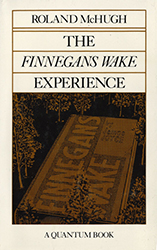
The Finnegans Wake Experience
By Roland McHugh
University of California Press, 1981
Available online at: Internet Archive
Written by Roland McHugh, the author of Annotations to Finnegans Wake, The Finnegans Wake Experience is a broad overview of the book, its critical history, and its impact on literature.
Contents:
- Samples
- Learning to Read Finnegans Wake
- Other People’s Opinions
- The British Museum Manuscripts
- The Buffalo Notebooks
- Ireland and Finnegans Wake
Lots of Fun at Finnegans Wake: Unravelling Universals

Lots of Fun at Finnegans Wake: Unravelling Universals
By Finn Fordham
Oxford University Press, 2007
Publisher’s Description: This book is a critical introduction to Finnegans Wake and its genesis. As well as offering a survey of critical, scholarly and theoretical approaches to Joyce’s masterpiece, it analyses in detail the compositional development of certain key passages which describe the artist (Shem) and his project; the river-mother (ALP) and her “first kiss”; the Oedipal shooting of the universal father (HCE) by the priestly son (Shaun); and the bewitching and curious daughter (Issy). The analyses demonstrate “genetic” ways of reading the text which illustrate its immense range and playfulness and how these qualities were generated in composition.
How Joyce Wrote Finnegans Wake: A Chapter-by-Chapter Genetic Guide
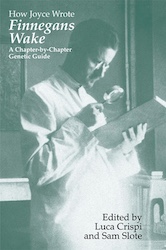
How Joyce Wrote Finnegans Wake: A Chapter-by-Chapter Genetic Guide
Edited by Luca Crispi & Sam Slote
University of Wisconsin Press, 2008
Publisher’s Description: In this landmark study of James Joyce’s Finnegans Wake, Luca Crispi and Sam Slote have brought together fourteen other leading Joyce experts in a genetic guide to one of the twentieth century’s most intriguing works of fiction. Each essay approaches Finnegans Wake through novel perspectives afforded by Joyce’s preparatory manuscripts. By investigating a work through its manuscripts, genetic criticism both grounds speculative interpretations in an historical, material context and opens up a broader horizon for critical and textual interpretation. The introduction by Luca Crispi, Sam Slote, and Dirk Van Hulle offers a chronology of the composition of Finnegans Wake, an archival survey of the manuscripts, and an introduction to genetic criticism. Then, the volume provides a chapter-by-chapter interpretation of the Wake, probing the book as a work in progress. This book is the essential starting point for all future studies of Joyce’s most complex and fascinating work. The book includes essays by Bill Cadbury, Luca Crispi, Jed Deppman, Daniel Ferrer, Finn Fordham, Mikio Fuse, David Hayman, Ingeborg Landuyt, Geert Lernout, Patrick A. McCarthy, Jean-Michel Rabaté, R.J. Schork, Sam Slote, Dirk Van Hulle, and Wim Van Mierlo.
James Joyce’s “Work in Progress”: Pre-Book Publications of Finnegans Wake Fragments
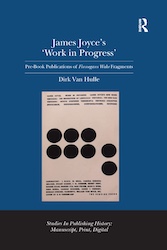
James Joyce’s “Work in Progress”: Pre-Book Publications of Finnegans Wake Fragments
By James Joyce. Edited by Dick Van Hulle
Routledge, 2019
Publisher’s Description: The text of Finnegans Wake is not as monolithic as it might seem. It grew out of a set of short vignettes, sections and fragments. Several of these sections, which James Joyce confidently claimed would “fuse of themselves” are still recognizable in the text of Finnegans Wake. And while they are undeniably integrated very skillfully, they also function separately. In this publication history, Dirk Van Hulle examines the interaction between the private composition process and the public life of Joyce’s “Work in Progress,” from the creation of the separate sections through their publication in periodicals and as separately published sections. Van Hulle highlights the beautifully crafted editions published by fine arts presses and Joyce’s encouragement of his daughter’s creative talents, even as his own creative process was slowing down in the 1930s. All of these pre-book publications were “alive” in both bibliographic and textual terms, as Joyce continually changed the texts in order to prepare the book publication of Finnegans Wake. Van Hulle’s book offers a fresh perspective on these texts, showing that they are not just preparatory versions of Finnegans Wake but a “Work in Progress” in their own right.
Finnegans Wakes: Tales of Translation
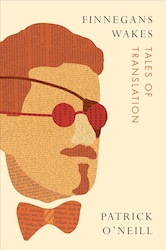
Finnegans Wakes: Tales of Translation
By Patrick O’Neill
University of Toronto Press, 2022
Publisher’s Description: James Joyce’s astonishing final text, Finnegans Wake (1939), is universally acknowledged to be entirely untranslatable. And yet, no fewer than fifteen complete renderings of the 628-page text exist to date, in twelve different languages altogether—and at least ten further complete renderings have been announced as underway for publication in the early 2020s, in nine different languages. Finnegans Wakes delineates, for the first time in any language, the international history of these renderings and discusses the multiple issues faced by translators. The book also comments on partial and fragmentary renderings from some thirty languages altogether, including such perhaps unexpected languages as Galician, Guarani, Chinese, Korean, Turkish, and Irish, not to mention Latin and Ancient Egyptian. Excerpts from individual renderings are analysed in detail, together with brief biographical notes on numerous individual translators. Chronicling renderings spanning multiple decades, Finnegans Wakes illustrates the capacity of Joyce’s final text to generate an inexhaustible multiplicity of possible meanings among the ever-increasing number of its impossible translations.
CONTINUE TO > Finnegans Wake Independent Criticism
Joyce Criticism
[Main Page | General Criticism | Dubliners | Portrait | Ulysses | Finnegans Wake]
Author: Allen B. Ruch
Artwork: Loui Jover
Last Modified: 14 June 2024
Main Joyce Page: The Brazen Head
Contact: quail(at)shipwrecklibrary(dot)com

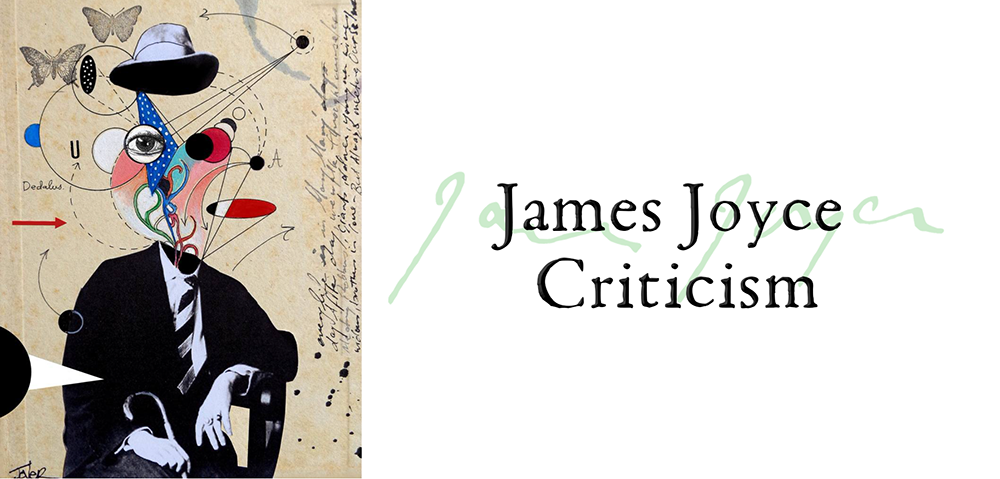
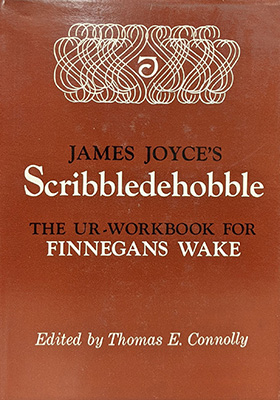
Shaharee Vyaas
My wife threw the book almost into the dumpster fire after reading half a page. The impression exists that only accomplished philologists are able to read Finnegans Wake. All the other ones have to relay upon heavily annotated versions. So I took it upon me to merge Finnegans Wake with the most beautiful book ever printed (the Kelsey-Chaucer), replaced all the foreign language idiosyncrasies with their English equivalent and streamlined Joyce’s sibylline prose. Here Comes Everybody’s Karma (isbn 9781737783299) will be released on June 11, 2024 in Dublin at the Bloomfestival. After that, everybody will be able to judge if the book is the most elaborated literary hoax ever, or the work of a genius (OK, I admit, I have dumbed it down a little). I’m currently releasing excerpts on my website http://www.maharajagar.com and an ARC is available for reviewers at https://www.netgalley.com/catalog/book/358599